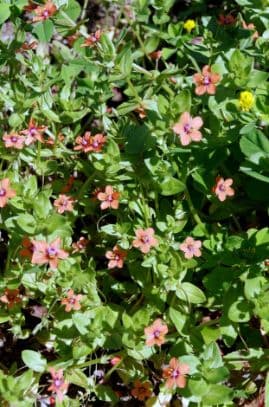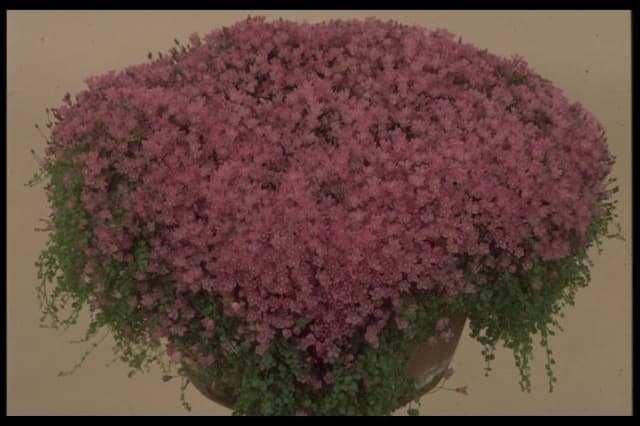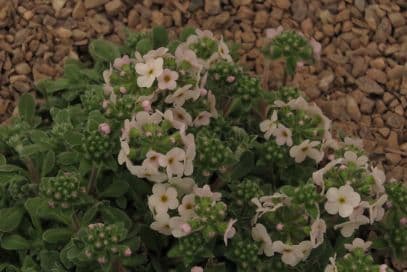Auricula Primula auricula hort. 'Joyce' (Au/a)

ABOUT
Primula auricula 'Joyce', commonly known as auricula or mountain cowslip, is a cultivated variety of flowering plant known for its unique and striking appearance. The plant features a rosette of green leaves that are somewhat rounded with a fleshy texture. These leaves typically have a smooth surface and can have a slightly powdery or velvety feel. The flowers of the auricula 'Joyce' are particularly showy and are the main attraction of the plant. The blooms come in a range of colors, often displaying deep, rich tones. Each flower consists of several rounded petals arranged in a circular pattern, resembling a small wheel. The flowers are centered with a contrasting, often bright, eye-catching color which may appear as a small, round area in the middle. These blooms are arranged in clusters on sturdy stems that rise above the foliage, creating a lovely contrast against the green leaves. The clusters can be quite dense, giving the appearance of a colorful bouquet sitting atop the plant. The overall effect of the auricula 'Joyce' flowers is one of intricate detail and delicate beauty, making it a popular choice for garden enthusiasts who appreciate its ornate appearance. While I can't mention the sizes, it is worth noting that the plant's growth habit allows it to fit comfortably in various garden settings or containers. Its compact form and eye-catching blooms make it a popular choice for alpine gardens, rockeries, and as a part of mixed borders or plant collections.
About this plant
 Names
NamesFamily
Primulaceae
Synonyms
Bear's Ear, Mountain Cowslip, Auricula
Common names
Primula auricula 'Joyce'.
 Toxicity
ToxicityTo humans
The plant known as Auricula is generally considered to have low toxicity to humans. However, it can cause mild irritation, particularly to sensitive individuals. If ingested, it may cause mild gastrointestinal disturbances such as nausea or vomiting. Skin contact with the sap can sometimes lead to dermatitis in some people. It is always advisable to handle plants with care and avoid ingestion, particularly with children and pets around.
To pets
Auricula is also considered to have low toxicity to pets. However, like in humans, ingestion could potentially lead to mild gastrointestinal upset, such as vomiting or diarrhea. It is not typically known for causing severe poisoning in pets, but as with any non-food plant, consumption should be discouraged to avoid any potential discomfort to the animal.
 Characteristics
CharacteristicsLife cycle
Perennials
Foliage type
Evergreen
Color of leaves
Green
Flower color
Varies
Height
6 inches (15 cm)
Spread
6 inches (15 cm)
Plant type
Herb
Hardiness zones
5
Native area
Europe
Benefits
 General Benefits
General Benefits- Aesthetic Appeal: Adds vibrant color and unique texture to gardens and landscapes with its striking, vividly hued flowers.
- Variety of Colors: Comes in a range of colors, offering options for gardeners looking to create specific color schemes.
- Compact Size: Its small size makes it suitable for rock gardens, front borders, or as part of a mixed container.
- Early Blooming: Often one of the first plants to flower in spring, providing an early splash of color after the winter months.
- Attracts Pollinators: Blossoms can attract beneficial insects such as bees and butterflies, which are important for pollination.
- Easy to Grow: Know for being a hardy plant that doesn't require extensive care or gardening expertise.
- Low Maintenance: Once established, it requires minimal maintenance, making it a good choice for gardeners seeking low-effort plants.
- Cold Tolerant: Able to withstand cooler temperatures, which makes it compatible with a variety of climates and extends its growing season in certain regions.
- Perennial Growth: As a perennial, it returns each year, providing long-term value and reducing the need for annual replanting.
- Non-Invasive: Unlike some other plants, it does not typically spread uncontrollably, helping to maintain the intended garden design.
 Medical Properties
Medical PropertiesThis plant is not used for medical purposes.
 Air-purifying Qualities
Air-purifying QualitiesThis plant is not specifically known for air purifying qualities.
 Other Uses
Other Uses- Artistic Inspiration: The Primula auricula, with its unique and vibrant colors, often serves as an inspiration for artists and illustrators in creating botanical art or designs for fabrics and wallpapers.
- Education: Can be used as a tool in educational settings for teaching botany and the importance of plant diversity, particularly in discussions about alpine flora or specialized plant breeding.
- Photography Prop: Its distinctive appearance makes it an attractive subject for photographers, particularly those specializing in macro and nature photography.
- Crafting: The flowers may be used in dried floral crafts, such as making bookmarks, greeting cards or in pressed flower projects.
- Special Events Decoration: Due to their ornamental beauty, these flowers can be used to decorate for special events like garden-themed weddings or spring celebrations.
- Collecting: Primula auricula enthusiasts often collect and showcase various cultivars, sharing them in auricula theaters, which are special tiered stands designed to display these plants.
- Garden Design: With its compact size, the auricula can be used in rock gardens or small-space gardening to create intricate and detailed designs.
- Herbarium Specimens: Can be preserved and used as herbarium specimens for scientific study and for reference in botanical gardens.
- Companion Planting: They can be strategically planted in gardens to complement other plants; their earlier blooming time can offer an extended flowering season when paired with late bloomers.
- Culinary Presentation: While not commonly eaten, the non-toxic flowers could potentially be used as a decorative, edible garnish on plates for high-end culinary presentations.
Interesting Facts
 Feng Shui
Feng ShuiThe Bear's Ear is not used in Feng Shui practice.
 Zodiac Sign Compitability
Zodiac Sign CompitabilityThe Bear's Ear is not used in astrology practice.
 Plant Symbolism
Plant Symbolism- Preciousness: The Primula auricula, often referred to as Auricula, is a unique and prized flower among gardeners, symbolizing something cherished and highly esteemed.
- Daintiness: With its small, delicate blooms, the Auricula represents fine and exquisite beauty, much like something that is dainty and elegant.
- Boldness in Adversity: Auriculas are known for their ability to thrive in alpine environments, symbolizing the courage to stand strong even in difficult conditions.
- Pride: In the Victorian language of flowers, Auriculas were often associated with pride, possibly due to their upright posture and the way they hold their blooms.
- Solitude: The Auricula's preference for cool, shaded areas and its solitary blooms can symbolize a peaceful solitude or the beauty of being alone.
 Water
WaterFor the Bear's Ear (Primula auricula 'Joyce'), it's important to keep the soil consistently moist but not soggy. Water the plant thoroughly when the top inch of soil feels dry to the touch, which typically equates to once or twice a week, depending on the humidity and temperature. Apply water directly to the base of the plant to avoid wetting the foliage, which can lead to fungal diseases. During the growing season, you may need about one gallon of water per week for an outdoor plant, but always adjust according to weather conditions and soil drainage.
 Light
LightBear's Ears (Primula auricula 'Joyce') thrives in partial shade to filtered sunlight. They prefer a spot that is shielded from the harsh afternoon sun, which can damage their delicate petals. A location that offers morning sunlight and afternoon shade is ideal for promoting vigorous growth and vibrant blooms.
 Temperature
TemperatureBear's Ear (Primula auricula 'Joyce') grows best in cooler temperatures and can tolerate a range from 40 to 75 degrees Fahrenheit. Protect the plant from temperatures above 80 degrees Fahrenheit, as it prefers the cooler end of the spectrum. The ideal temperature range for active growth is between 50 and 60 degrees Fahrenheit.
 Pruning
PruningPrune Bear's Ear (Primula auricula 'Joyce') to remove dead or fading flowers and to maintain plant shape. This encourages the plant to produce more blooms and prevents energy from being wasted on seed production. Pruning is best done immediately after flowering, and deadheading can be performed as needed throughout the blooming season.
 Cleaning
CleaningAs needed
 Soil
SoilAuricula Primrose 'Joyce' prefers well-draining soil with a mix of loam, peat, and a little grit to improve drainage, often in equal parts. Maintain a soil pH of 6.0 to 7.0 for optimal growth.
 Repotting
RepottingAuricula Primrose 'Joyce' should be repotted annually in late summer or early autumn, after the blooming period, to maintain health and vigour.
 Humidity & Misting
Humidity & MistingAuricula Primrose 'Joyce' thrives best in moderate humidity conditions but can tolerate a range; just avoid excessively dry air which can stress the plant.
 Suitable locations
Suitable locationsIndoor
Place in bright, indirect light; water moderately.
Outdoor
Plant in partial shade, sheltered from strong winds.
Hardiness zone
4-8 USDA
 Life cycle
Life cycleThe 'Joyce' auricula, a variety of Primula auricula, begins its life as a seed, typically sown in late winter to early spring under cover or in a cold frame. Upon germination, the seedling develops its first leaves and after a few weeks, true leaves appear, at which point it may be pricked out into individual pots if not directly sown there. As a perennial, 'Joyce' auricula grows and establishes a rosette of leaves in its first year, but may not flower until the following spring. Flowering typically occurs in mid-spring, producing clusters of ornate, multicolored blooms that attract pollinators and are highly prized by gardeners. After blooming, it sets seed which can be collected or allowed to self-sow if conditions are suitable. The plant typically enters a period of dormancy during the late summer to fall, reducing above-ground growth and storing energy in its roots for the next growing season.
 Propogation
PropogationPropogation time
Spring-Early Summer
Propogation: The Primula auricula, commonly referred to as Auricula or Bear's Ear, is a delightful perennial whose propagation is commonly done through division, which tends to be the most popular method. This is ideally carried out after the plant has finished flowering, which typically occurs in late spring or early summer. To propagate by division, gently lift the plant from the soil, and carefully separate it into smaller clumps, ensuring that each clump has a share of roots. These clumps can then be immediately replanted into well-drained soil, preferably enriched with compost to give them a healthy start. Water the new plantings gently but thoroughly, aiming for about 1 inch of water (approximately 2.54 centimeters or 25.4 millimeters) to help establish them in their new locations. This method allows gardeners to quickly increase their stock of Auriculas while maintaining the distinct characteristics of the 'Joyce' variety.









